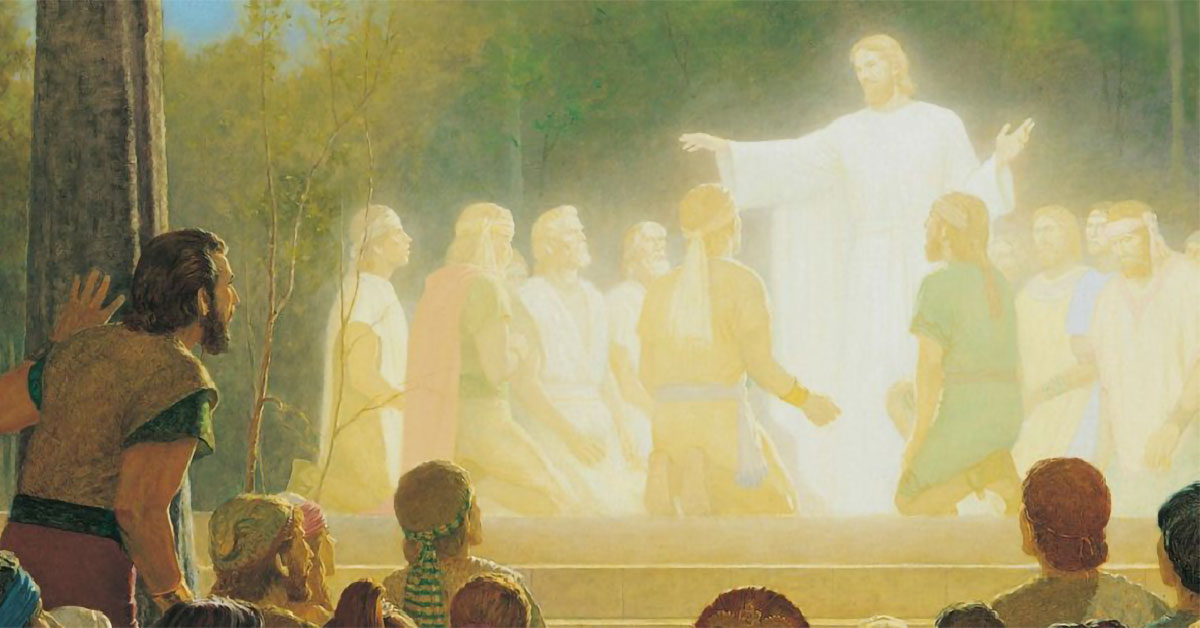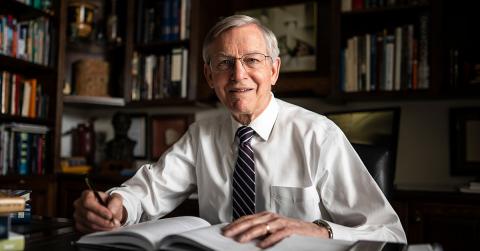You are here
Book of Mormon Central is in the process of migrating to our new Scripture Central website.
We ask for your patience during this transition. Over the coming weeks, all pages of bookofmormoncentral.org will be redirected to their corresponding page on scripturecentral.org, resulting in minimal disruption.
Come Follow Me 2020: 3 Nephi 17-19

Scripture Block
3 Nephi 17-19
September 28–October 11. “Behold, My Joy Is Full”
Recommended Resources
Learn about the Book of Mormon with verse by verse commentaries from renowned Book of Mormon scholars like John W. Welch and Brant A. Gardner in the ScripturePlus app. Read this week's KnoWhy connected with the Come Follow Me curriculum, and watch a video elucidating an insight in this week's scripture reading.
KnoWhys
Reading Plan
Structure your personal scripture study by following a multimedia, day by day plan. Each day's assignment includes the required scripture passages from the Come Follow Me curriculum, as well as suggestions for additional resources to bring context and understanding to your study.
September 28–October 4: General Conference
Monday: General Conference
- KnoWhy 2: An Apostle's Witness
Tuesday: General Conference
Wednesday: General Conference
- KnoWhy 433: How Have LDS Women Shared the Book of Mormon?
Thursday: General Conference
- KnoWhy 368: Why Should We Read the Book of Mormon Daily?
Friday: General Conference
Saturday: General Conference
Sunday: General Conference
- KnoWhy 68: Why Do Church Leaders Frequently Testify of the Book of Mormon?
- KnoWhy 72: Was the Book of Mormon Used as the First Church Administrative Handbook?
October 5–October 11: 3 Nephi 17–19
Monday
- Scripture: 3 Nephi 17:1-10
-
Quote: “When the Savior appeared to the people of the Book of Mormon, He gave us a great example about not waiting to administer relief to those who have lost a sense of happiness and joy. Having taught the people, He saw that they were unable to understand all His words . . . As He concluded, He looked upon the multitude and saw them weeping, for they longed for Him to stay with them. ‘And he said unto them: Behold, my bowels are filled with compassion towards you’ . . . That is the model the Savior has given us. His love is for all, but He never loses sight of the one . . . We have a responsibility and a great opportunity. There are many who need to once again experience the sweet savor of happiness and joy through activity in the Church. That happiness comes from receiving the ordinances, making sacred covenants, and keeping them. The Lord needs us to help them. Let us do the right thing at the right time, without delay.”
Alonso, José L. “Doing the Right Thing at the Right Time, without Delay,” General Conference October 2011 -
Quote: “The Savior has given us a pattern to follow as we study the scriptures. We hear the word, we ponder upon its meaning, we ask our Heavenly Father to help us understand, and then our minds and hearts are prepared to receive the promised blessings. Pondering is more than reading words; it is searching for meanings that will help us as we relate to one another and as we make choices in our lives. It is allowing the word to move from our minds to our hearts. The Spirit bears witness to our hearts as we prayerfully seek to know the things of our Heavenly Father. When we have that witness and knowledge, we think and live and relate to each other in more Christlike ways.”
Wirthlin, Anne G. “Teaching Our Children to Love the Scriptures,” General Conference, April 1998. - KnoWhy 209: Why Did Jesus Minister to the People One by One?
Tuesday
- Scripture: 3 Nephi 17:11-25
- KnoWhy 372: Why is Joy Associated with Temple Work in the Scriptures?
- KnoWhy 210: Why Has 3 Nephi Been Called the Crown Jewel of the Book of Mormon?
Wednesday
- Scripture: 3 Nephi 18:1-16
- KnoWhy 211: Why Did the Savior Emphasize His Risen Body in the Nephite Sacrament?
-
Quote: “Those who partake worthily of the sacramental emblems, by so doing, covenant on their part to remember the body of the Son of God who was crucified for them; to take upon them his name, as they did in the waters of baptism; and to ‘always remember him and keep his commandments which he has given them; that they may always have his Spirit to be with them.’ (D&C 20:77.) Thus those who partake worthily of the sacrament – and the same repentance and contrition and desires for righteousness should precede the partaking of the sacrament as precede baptism – all such receive the companionship of the Holy Spirit. Because the Spirit will not dwell in an unclean tabernacle, they thus receive a remission of their sins through the sacramental ordinance. Through this ordinance the Lord puts a seal of approval upon them; they are renewed in spirit and become new creatures of the Holy Ghost, even as they did at baptism; they put off the old man of sin and put on Christ whose children they then are."
McConkie, Bruce R. A New Witness for the Articles of Faith. Salt Lake City, UT: Deseret Book Co., 1985, 239–240 -
Quote: “There is much more to say about memory and remembering in the gospel of Jesus Christ. We often speak of remembering our sacred covenants and God’s commandments and of remembering and performing saving ordinances for our deceased ancestors. Most importantly, we speak of the need to remember our Savior Jesus Christ and not just when convenient, but always, as He asks. We witness always to remember Him as we partake of the sacrament. In return, we are promised His Spirit will always be with us. Interestingly, this is the same Spirit sent by our Heavenly Father to ‘bring all things to [our] remembrance.’ Thus, by worthily receiving the sacrament, we are blessed by the Spirit to enter into a wonderfully beneficial circle of remembering, returning again and again in our thinking and devotion to Christ and His Atonement.”
Jensen, Marlin K. “Remember and Perish Not,” General Conference April 2007.
Explore Further
Thursday
- Scripture: 3 Nephi 18:17-25
- KnoWhy 344: Why Does Jesus Say that “Ye Must Watch and Pray Always”?
-
Quote: “I know of no single practice that will have a more salutary effect upon your lives than the practice of kneeling together as you begin and close each day. Somehow the little storms that seem to afflict every marriage are dissipated when, kneeling before the Lord, you thank him for one another, in the presence of one another, and then together invoke his blessings upon your lives, your home, your loved ones, and your dreams.”
Hinckley, Gordon B. “Except the Lord Build the House. . .” Ensign, June 1971, 72.
Explore Further
Friday
- Scripture: 3 Nephi 18:26-39
-
Quote: “Thus ended the first day. The incomparable Sermon at the Temple was over. It was a manifestation of divine will and presence never to be forgotten. From this experience come many things: teachings of practical ethical value; an understanding of that which was fulfilled and that which remained yet to be fulfilled; a comprehension of the continuity and transition from the old law to the new; knowledge and testimony of the resurrection and exaltation of Jesus Christ; commandments and covenants; and also a basis for religious ritual”.
Welch, John W. Sermon at the Temple and the Sermon on the Mount: A Latter-day Saint Approach, Provo, Utah: Foundation for Ancient Research and Mormon Studies, 2010, 82 -
Quote: “When the Savior left his disciples after his first appearance to them, ‘he touched with his hand the disciples whom he had chosen, one by one, even until he had touched them all, and spake unto them as he touched them. . . . the disciples bare record that he gave them power to give the Holy Ghost. And I will show unto you hereafter that this record is true.’ (3 Nephi 18:36-37.)
“Evidently the pronoun I in this quotation refers to the historian Mormon when he promises ‘I will show unto you hereafter that this record is true’; that is, Mormon is going to show later in his record that the Savior did give the disciples the power to bestow the Holy Ghost. Some persons might question whether or not Mormon does indicate this later in his record. However, it is of interest to note that as soon as Moroni starts writing, he gives us the exact wording of the prayer of the Savior on this occasion. (See Moroni 2.)”
Ludlow, Daniel H. A Companion to Your Study of the Book of Mormon. Salt Lake City: Deseret Book, 1976, 274-275.
Explore Further
Saturday
- Scripture: 3 Nephi 19:1-14
-
Quote: “When we have the Spirit with us, our spiritual senses are sharpened and our memory is kindled so we cannot forget the miracles and signs we have witnessed. That may be why, knowing Jesus was about to leave them, His Nephite disciples prayed fervently ‘for that which they most desired; and they desired that the Holy Ghost should be given unto them.’ Although they had seen the Savior with their own eyes and had touched His wounds with their own hands, they knew that their testimonies might dwindle without being constantly renewed by the power of the Spirit of God. My brothers and sisters, never do anything to risk the loss of this precious and marvelous gift—the companionship of the Holy Ghost. Seek it through fervent prayer and righteous living.”
Caussé, Gérald. “Is It Still Wonderful to You?”. General Conference April 2015 -
Quote: “The symbol of the Holy Ghost is fire. The people were encircled about ‘as if it were by fire’—again not our usual fire, but the radiance, brilliance, light, or glory that accompanied angelic ministrants from heaven”
Ogden, D. Kelly, and Andrew C. Skinner. Verse by Verse: The Book of Mormon. 2 Volumes. Salt Lake City, UT: Deseret Book, 2011, 2:190. - KnoWhy 213: Why Is 3 Nephi Important for Understanding the Godhead?
Sunday
- Scripture: 3 Nephi 19:15-36
-
Quote: “On that Pentecostal occasion when the Nephites received the gift of the Holy Ghost, they offered approved prayers directly to Jesus and not to the Father. But there was a special reason why this was done in this instance. … Jesus was present before them as the symbol of the Father [see 3 Nephi 19:22]. Seeing him, it was as though they saw the Father; praying to him, it was as though they prayed to the Father. It was a special and unique situation that as far as we know has taken place only once on earth during all the long ages of the Lord’s hand-dealings with his children”.
McConkie, Bruce R. The Promised Messiah: The First Coming of Christ. Salt Lake City: Deseret Book, 1982, 560-561. - KnoWhy 212: Why Did Jesus Allude to the Priestly Blessing in Numbers 6?
Additional Resources (Bibliography)
3 Nephi 17
Christ in America Timeline. Springville, UT: Book of Mormon Central, 2016.
What Would Jesus Do? (3 Nephi 11-28). Springville, UT: Book of Mormon Central, 2016.
Sweat, Anthony. “Active Learning and the Savior's Nephite Ministry.” Religious Educator 10, no. 3 (2009): 75–86.
3 Nephi 17:7
Sorenson, John L. “Was There Leprosy Among the Nephites?” In Pressing Forward with the Book of Mormon: The FARMS Updates of the 1990s, edited by John W. Welch and Melvin J. Thorne, 231–233. Provo, UT: FARMS, 1999.
3 Nephi 17:16–25
Tolley, Kevin L. “To ‘See and Hear.’” Interpreter: A Journal of Mormon Scripture 18 (2016): 139–158.
3 Nephi 17:17–18
Book of Mormon Central. “Why is Joy Associated with Temple Work in the Scriptures? (3 Nephi 17:17–18).” KnoWhy 210 (October 17, 2016).
3 Nephi 17:20–23
Book of Mormon Central. “Why Did Jesus Minister to the People One by One? (3 Nephi 17:21).” KnoWhy 209 (October 14, 2016).
Kerr, W. Rolfe. “Behold Your Little Ones.” General Conference October 1996.
Nattress, K. Brett. “No Greater Joy Than to Know That They Know.” General Conference October 2016.
3 Nephi 18
Christ in America Timeline. Springville, UT: Book of Mormon Central, 2016.
What Would Jesus Do? (3 Nephi 11-28). Springville, UT: Book of Mormon Central, 2016.
Perego, Ugo A. “The Changing Forms of the Latter-day Saint Sacrament.” Interpreter: A Journal of Mormon Scripture 22 (2016): 1–16.
Sweat, Anthony. “Active Learning and the Savior's Nephite Ministry.” Religious Educator 10, no. 3 (2009): 75–86.
Welch, John W. “Worthy of Another Look: Reusages of the Words of Christ.” Journal of the Book of Mormon and Other Restoration Scripture 22, no. 1 (2013): 62–72.
Welch, John W., and Greg Welch. “Book of Mormon Covenant Language.” In Charting the Book of Mormon: Visual Aids for Personal Study and Teaching. Provo, UT: Foundation for Ancient Research and Mormon Studies, 1999, chart 58.
Welch, John W. “From Presence to Practice: Jesus, the Sacrament Prayers, the Priesthood, and Church Discipline in 3 Nephi 18 and Moroni 2–6.” Journal of Book of Mormon Studies 5, no. 1 (1996): 119–139.
3 Nephi 18:7
Book of Mormon Central. “Why Did the Savior Emphasize His Risen Body in the Nephite Sacrament? (3 Nephi 18:7).” KnoWhy 211 (October 18, 2016).
Bowen, Matthew L. “’In the Mount of the Lord It Shall Be Seen’ and ‘Provided’: Theophany and Sacrifice as the Etiological Foundation of the Temple in Israelite and Latter-day Saint Tradition.” Interpreter: A Journal of Mormon Scripture 5 (2013): 201–228.
3 Nephi 18:12–13
Bowen, Matthew L. “Founded Upon a Rock: Doctrinal and Temple Implications of Peter’s Surnaming.” Interpreter: A Journal of Mormon Scripture 9 (2014): 1–28.
3 Nephi 18:15
Book of Mormon Central. “Why Does Jesus Say that “Ye Must Watch and Pray Always”? (3 Nephi 18:15).” KnoWhy 344 (July 26, 2017).
3 Nephi 18:21
Book of Mormon Central. “Where Did Joseph Smith Get His Teachings on the Family? (3 Nephi 18:21).” KnoWhy 285 (March 10, 2017).
Pinegar, Rex D. “The Simple Things.” General Conference October 1994.
3 Nephi 18:37
Book of Mormon Central. “Why Should Readers Pay Attention to the Book of Mormon’s Editorial Promises? (3 Nephi 18:37).” KnoWhy 510 (April 11, 2019).
3 Nephi 19
Christ in America Timeline. Springville, UT: Book of Mormon Central, 2016.
What Would Jesus Do? (3 Nephi 11-28). Springville, UT: Book of Mormon Central, 2016.
Sweat, Anthony. “Active Learning and the Savior's Nephite Ministry.” Religious Educator 10, no. 3 (2009): 75–86.
Welch, John W. “Worthy of Another Look: Reusages of the Words of Christ.” Journal of the Book of Mormon and Other Restoration Scripture 22, no. 1 (2013): 62–72.
3 Nephi 19:4
Ricks, Stephen D. “The name of one of the Lord’s disciples listed in 3 Nephi 19:4—Timothy—seems to be Greek in origin. Is there an explanation for the appearance of a Greek name in the Book of Mormon?” Ensign October 1992.
(Mathonihah) Tvedtnes, John A., John Gee, and Matthew Roper. “Book of Mormon Names Attested in Ancient Hebrew Inscriptions.” Journal of Book of Mormon Studies 9, no. 1 (2000): 40–51, 78–79.
3 Nephi 19:18
Spackman, Beth T. “In 3 Nephi 19, we read that some Nephites prayed to Jesus. Is it proper to pray to him?” Ensign June 1988.
3 Nephi 19:20, 28–29, 31–34
Welch, John W. “The Lord’s Prayers.” Ensign January 1976.
3 Nephi 19:23
Book of Mormon Central. “Why Is 3 Nephi Important for Understanding the Godhead? (3 Nephi 19:23).” KnoWhy 213 (October 20, 2016).
3 Nephi 19:25
Book of Mormon Central. “Why Did Jesus Allude to the Priestly Blessing in Numbers 6? (3 Nephi 19:25).” KnoWhy 212 (October 19, 2016).









